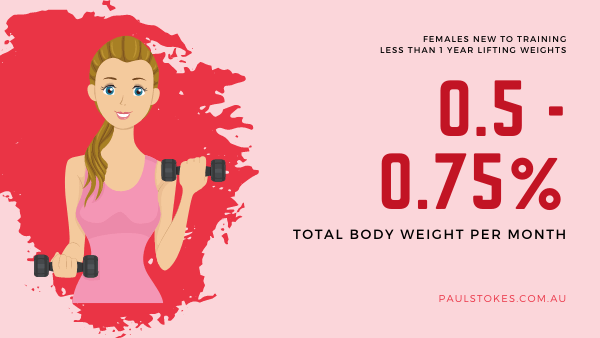Typically females shy away from weights and males gravitate toward them. However, both men and women should include weight training in their fitness regimes. Let's look at why.
More...
Men and women respond to weight training in the same way. Each sex's muscles gain strength, size and tone if we follow the overload principle.
Overload is the systematic and progressive use of heavier weights over time. Alternatively, if training with lighter weights, we can achieve overload with progressively more reps. Adaptation occurs as muscles 'grow' to be able to handle heavier resistance or more repetitions.
Men naturally have more muscle mass than women. This is mainly due to their naturally larger frames and 'starting' amounts of muscle. Additionally, they are usually able to develop bigger muscles. After all, men naturally possess greater levels of testosterone (an androgen hormone) in their bodies.
Are there male and female weight training exercises?
Take a look around your gym and you might think so.
For example, you'll probably see more women using the inner and outer thigh machines than men.
Then look over to the free weights area and you'll probably find it packed with the guys.
In my experience, women tend to want to work on their butt and thighs. Men generally choose to work on their chest and arms more often.
However, this 'weight training sex divide' is not based on physiology. Rather it's a matter of choice and even misinformation and stereotypical views.
Male soccer players could, for example, gain benefits from using the inner thigh machine to strengthen their kicking muscles. On the other hand, women performing free weight deadlifts will strengthen their backs and legs.
So, regardless of your sex, choose the 'right' and best exercises for you.
Consider your fitness level, your body shaping needs and your level of training experience. That way, you can customise your training to your own body, man or woman.
Weight training and fat burning
Women (and men) often don't appreciate just what a great fat burner weight training is.
Most people don't associate weight training with getting a sweat on, getting out of breath and consequentially burning substantial calories in contrast to cardio.
Weekly Calories
However, the more lean muscle a body has the better it is at burning fat. To a point.
Muscle is highly metabolically active body tissue.
A 0.45kg increase will result in around 350 more calories being burned a week, without any additional training. That's about the same number of calories you'd burn running at a moderate pace for 30-40 minutes.
Bear in mind, that's still only around 50 calories extra per day. However, you'll benefit from this fat-burning 24/7.

Women in their first year of training could expect to put on 0.5-0.75% of their body weight in lean muscle mass
Realistic muscle gains for men and women
The majority of men can expect to gain 0.5-1 kg of muscle per month as a result of a regular (two-three times a week) strength gain weight training programme.
Women should expect a 0.25 to 0.75kg gain from a similar routine, due to their smaller muscle mass and body size.
Those new to weight training generally experience greater initial gains. However, after a few years, progress will slow, perhaps to just a 0.5kg increase per month.
READ ALSO: How Quickly Can I Expect to Build Muscle?
To build bigger muscles, use medium to heavy weights workouts. Look at workouts that use weights at 70-80% of 1 rep max over 4-6 sets of 8-10 reps. Generally, these have the greatest muscle building anabolic effects.
Male and female muscle gain is a reflection of genetic potential rather than an individual's sex.
Some people, particularly those with larger athletic frames - endomorphs, will find it easier to build muscle than ectomorphs with slighter frames.
Muscle myths when it comes to men and women weight training
The simple answer is no.
Muscle does not turn to fat as many people think when they stop weight training. It is a completely different type of body tissue.
However, if you stop training, muscle will lose strength and size regardless of sex. We gain fat simply because our body not burning as many calories as it did when we were weight training.
If you are a serious weight lifter, then regardless of sex there is a risk that constant deep squatting, for example, could damage the knee joints. Especially in an older or less conditioned trainer.
That being said, for the majority of men and women weight training will actually strengthen the ligaments and tendons that support joints. As a result, your joints become stronger too.
However, women's knees are more likely to sustain damage than men.
Due to the female anatomy and the strength ratio between the muscles at the back and front of their thighs. Leg extensions, lunges and leg curls are therefore great exercises for women as they can reduce the potential for a knee injury.
If you want increased muscle mass and you are not over-fat then regular and intense aerobic exercise can actually hamper your body shaping.
This is because
1) aerobic training works against strength training.
In essence, two contrasting energy systems are trained at the same time, compromising strength and size gains
2) extreme aerobic training can use muscle protein as an energy source.
This can effectively 'eat away' at your shape since muscle is primarily made from protein.
Muscles can shorten as a result of prolonged (primarily heavy) weight training, irrespective of sex.
However, regardless of whether you are male or female, you will not lose flexibility if
- you use proper technique,
- do not perform the same exercises week in week out,
- stretch after your workouts and
- vary the weight lifted.
Certain exercises, such as dumbbell flyes and squats can actually increase your range of movement.
